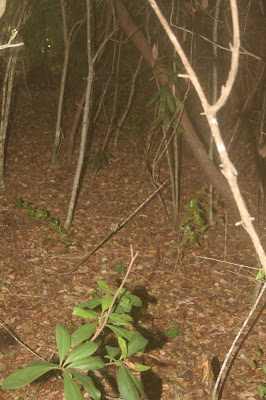Written by the TreasureGuide for the exclusive use of the Treasure Beaches Report.
 |
| Rough Map of Partially Cleared Lot Being Detected. |
There were wire barrel loops scattered all over the middle third of the lot (red circles). Individual spikes, bolts and anchors are scattered around too.
 |
| Individual Scattered Items Found in This Area - No Apparent Groupings. |
I discovered an area of several square yards where I dug probably around thirty rail anchors, fish bolts and railroad spikes. They were packed so close together that they were hard to pinpoint and remove. Most were one to two feet deep. I have not removed all the signals from that area yet. I intend to.
 Area A Where Much Railroad Hardware Dug. |
Associated with that grouping was two barrel or keg hoops with all the nails still in place and a twisted wire loop that would have gone around the center of the barrel. Those three hoops were together on top of each other, and so with the nails still in place in the hoops, it looked to me as if the barrel wood deteriorated in place. It might be that the hardware was in the barrel when it was abandoned, but I'm not sure of that. If so, it looks like somehow the hardware got scattered around a bit.
The third area of interest for me is labeled D on the site map. That is where I found part of a two-sided enameled sign and a drinking cup. There are stones and pieces of concrete also in that area. That area definitely needs more exploration.
 |
| Area D. Sign and Cup Found Here. |
A second similar tin cup was discovered towards the center of the site. You can see that on the map. It did not seem to be associated with any other items.
The area to the east (bottom of the map) produced a few miscellaneous items, including a 22 shell, a shotgun shell, and a modern penny and some modern junk. That area has not produced much railroad hardware - just a few scattered iron items.
 |
| Most Cleared Area. No Groupings Discovered Here |
What I've learned so far is that there are a lot of items on this lot. I didn't really expect so much. Many items have been found in the first few explorations, and from what I've seen so far, it will undoubtedly take many days to completely detect this lot. So far I've mostly removed big iron items. I'm sure smaller items will come later.
The railroad items seem to be from the same time period. I haven't found anything to help me date them yet, but hope to eventually find some clues that will help me do thatk. Maybe they were from when the railroad was constructed. I don'know. I can't account for why there are so many barrel or keg hoops scattered around, or why there is so much railroad hardware scattered around. From the many hoops I've found, at least a dozen barrels are represented. And they are at least fifty to a hundred yards from the tracks.
I've not done a systematic thorough search yet - just an informal sampling. I'm hoping to find some items that are marked or that give a more specific time period.
I always say you can find something anywhere, but I never guessed this lot would have so much.
Relic hunting is definitely not as easy or pleasant as beach hunting. You can't use a scoop in a place like this. There is a lot of junk iron. When you get a signal and start to dig, first you hit a mat of small roots and then a bunch of bigger roots. You usually have to cut through some hefty roots before you can get an item out of the ground.
There are some similarities to beach hunting though. There is clustering, although it is a different kind of clustering. On an inland site, the clustering is not from the sifting and sorting of beach sand. Nonetheless, you assess the site and put together clues very much as you would on a beach.
I'll have the big items removed from a few areas soon. I'd expect to start getting some smaller items then.
---
The Egyptian mission under Zahi Hawass discovered an ancient Egyptian city in Luxor - The Rise of Aten - that was lost under the sands 3000 years ago...
The excavation started in September 2020, and within weeks, to the team’s great surprise, formations of mud bricks began to appear in all directions. What they unearthed was the site of a large city in good condition of preservation, with almost complete walls and with rooms filled with tools for daily life.
The archaeological layers have laid untouched for thousands of years, left by the ancient residents as if it were yesterday.
The first goal of the mission was to date this settlement using hieroglyphic inscriptions found on clay caps of wine vessels. Historical references tell us the settlement consisted of three royal palaces of king Amenhotep III, as well as the empire’s administrative and industrial centre.
A large number of archaeological finds, such as rings, scarabs, coloured pottery vessels, and mud bricks bearing seals of king Amenhotep III’s cartouche, confirmed the dating of the city...
---
 |
| Source: MagicSeaWeed.com. |
Three to four foot surf, but the wind is from the south.
Happy hunting,
TreasureGuide@comcast.net